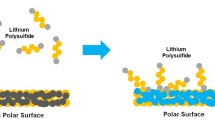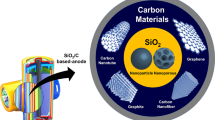Abstract
For solving the problems of the poor electronic conductivity and volume change of sulfur particles, the shuttle effect of the soluble polysulfides, we design multifunctional host materials for the element sulfur by using hollow graphene and SnO2 composite spheres (HGSn). In this multifunctional host materials, graphene can significantly improve the electronic conductivity and the hollow sphere structure of HGSn proved by TEM can buffer the volume change of the discharge and charge products. Moreover, HGSn could provide physical adsorption and chemical affinity by forming C=S bond and S–Sn–O bond to greatly alleviate the polysulfide shuttle effect, which were represented by UV–Vis and FT-IR spectra, respectively. As a result, the as-prepared HGSn/S electrodes exhibit good electrochemical performance with high sulfur loading of 2.25 mg cm−2. The discharge specific capacity is 706.82 mAh g−1 after 200 cycles and 604.93 mAh g−1 after 350 cycles at 0.2C, and the capacity retention is 80.90% and 69.37% with average capacity attenuation of 0.096% and 0.088% for each cycle.







Similar content being viewed by others
References
Larcher D, Tarascon JM (2015) Towards greener and more sustainable batteries for electrical energy storage. Nat Chem 7(1):19–29
Natarajan S, Aravindan V (2018) Recycling strategies for spent Li-ion battery mixed cathodes. ACS Energy Lett 3(9):2101–2103
Winslow KM, Laux SJ, Townsend TG (2018) A review on the growing concern and potential management strategies of waste lithium-ion batteries. Resour Conserv Recycl 129:263–277
Zhong Y, Chao D, Deng S, Zhan J, Fang R, Xia Y, Wang Y, Wang X, Xia X, Tu J (2018) Confining sulfur in integrated composite scaffold with highly porous carbon fibers/vanadium nitride arrays for high-performance lithium–sulfur batteries. Adv Func Mater 28(38):1706391
Chen W, Lei T, Qian T, Lv W, He W, Wu C, Liu X, Liu J, Chen B, Yan C (2018) A new hydrophilic binder enabling strongly anchoring polysulfides for high-performance sulfur electrodes in lithium–sulfur battery. Adv Energy Mater 8(12):1702889
Kong L, Li BQ, Peng HJ, Zhang R, Xie J, Huang JQ, Zhang Q (2018) Porphyrin-derived graphene-based nanosheets enabling strong polysulfide chemisorption and rapid kinetics in lithium–sulfur batteries. Adv Energy Mater 8(20):1800849
Wu H, Li Y, Ren J, Rao D, Zheng Q, Zhou L, Lin D (2019) CNT-assembled dodecahedra core@ nickel hydroxide nanosheet shell enabled sulfur cathode for high-performance lithium–sulfur batteries. Nano Energy 55:82–92
Zhou F, Li Z, Luo X, Wu T, Jiang B, Lu L-L, Yao H-B, Antonietti M, Yu S-H (2018) Low cost metal carbide nanocrystals as binding and electrocatalytic sites for high performance Li–S batteries. Nano Lett 18(2):1035–1043
Hernández-Rentero C, Córdoba R, Moreno N, Caballero A, Morales J, Olivares-Marín M, Gómez-Serrano V (2018) Low-cost disordered carbons for Li/S batteries: a high-performance carbon with dual porosity derived from cherry pits. Nano Res 11(1):89–100
Yang W, Yang W, Song A, Sun G, Shao G (2017) 3D interconnected porous carbon nanosheets/carbon nanotubes as a polysulfide reservoir for high performance lithium–sulfur batteries. Nanoscale 10(2):816–824
Zhang X-Q, He B, Li W-C, Lu A-H (2018) Hollow carbon nanofibers with dynamic adjustable pore sizes and closed ends as hosts for high-rate lithium–sulfur battery cathodes. Nano Res 11(3):1238–1246
He J, Hartmann G, Lee M, Hwang GS, Chen Y, Manthiram A (2019) Freestanding 1T MoS2/graphene heterostructures as a highly efficient electrocatalyst for lithium polysulfides in Li–S batteries. Energy Environ Sci 12:344–350
Fang R, Zhao S, Sun Z, Wang DW, Cheng HM, Li F (2017) More reliable lithium–sulfur batteries: status, solutions and prospects. Adv Mater 29(48):1606823
You Y, Ye Y, Wei M, Sun W, Tang Q, Zhang J, Chen X, Li H, Xu J (2019) Three-dimensional MoS2/rGO foams as efficient sulfur hosts for high-performance lithium–sulfur batteries. Chem Eng J 355:671–678
Wang M, Fan L, Wu X, Tian D, Cheng J, Qiu Y, Wu H, Guan B, Zhang N, Sun K (2017) Hierarchical mesoporous SnO2 nanosheets on carbon cloth toward enhancing the polysulfides redox for lithium–sulfur batteries. J Mater Chem A 5(37):19613–19618
Li G, Wang X, Seo MH, Li M, Ma L, Yuan Y, Wu T, Yu A, Wang S, Lu J (2018) Chemisorption of polysulfides through redox reactions with organic molecules for lithium–sulfur batteries. Nat Commun 9(1):705
Jeong YC, Kim JH, Nam S, Park CR, Yang SJ (2018) Rational design of nanostructured functional interlayer/separator for advanced Li–S batteries. Adv Funct Mater 28(38):1707411
Zhang SS (2012) Effect of discharge cutoff voltage on reversibility of lithium/sulfur batteries with LiNO3-contained electrolyte. J Electrochem Soc 159(7):A920–A923
Wang Y, Sahadeo E, Rubloff G, Lin C-F, Lee SB (2019) High-capacity lithium sulfur battery and beyond: a review of metal anode protection layers and perspective of solid-state electrolytes. J Mater Sci 54(5):3671–3693. https://doi.org/10.1007/s10853-018-3093-7
Ma L, Zhang W, Wang L, Hu Y, Zhu G, Wang Y, Chen R, Chen T, Tie Z, Liu J (2018) Strong capillarity chemisorption, and electrocatalytic capability of crisscrossed nanostraws enabled flexible, high-rate, and long-cycling lithium–sulfur batteries. ACS Nano 12(5):4868–4876
Cha E, Patel MD, Park J, Hwang J, Prasad V, Cho K, Choi W (2018) 2D MoS2 as an efficient protective layer for lithium metal anodes in high-performance Li–S batteries. Nat Nanotechnol 13(4):337–344
Park GD, Jung DS, Lee J-K, Kang YC (2019) Pitch-derived yolk–shell-structured carbon microspheres as efficient sulfur host materials and their application as cathode material for Li–S batteries. Chem Eng J 373:382–392
Tan L, Li X, Wang Z, Guo H, Wang J (2018) Lightweight reduced graphene oxide@ MoS2 interlayer as polysulfide barrier for high-performance lithium–sulfur batteries. ACS Appl Mater Interfaces 10(4):3707–3713
Li P, Deng J, Li J, Guo J, Zeng M, Wang L, Wang R, Tang M (2019) Bifunctional interlayer for capturing polysulfide in Li–S battery. J Mater Sci 54(18):11983–11990. https://doi.org/10.1007/s10853-019-03755-7
Tang H, Yao S, Xue S, Liu M, Chen L, Jing M, Shen X, Li T, Xiao K, Qin S (2018) In-situ synthesis of carbon@ Ti4O7 non-woven fabric as a multi-functional interlayer for excellent lithium–sulfur battery. Electrochimica Acta 263:158–167
Zheng B, Yu L, Zhao Y, Xi J (2019) Ultralight carbon flakes modified separator as an effective polysulfide barrier for lithium–sulfur batteries. Electrochimica Acta 295:910–917
Jiang G, Zheng N, Chen X, Ding G, Li Y, Sun F, Li Y (2019) In-situ decoration of MOF-derived carbon on nitrogen-doped ultrathin MXene nanosheets to multifunctionalize separators for stable Li–S batteries. Chem Eng J 373:1309–1318
He J, Chen Y, Manthiram A (2018) Vertical Co9S8 hollow nanowall arrays grown on Celgard separator as a multifunctional polysulfide barrier for high-performance Li–S batteries. Energy Environ Sci. https://doi.org/10.1039/C8EE00893K
Jiang H, Liu XC, Wu Y, Shu Y, Gong X, Ke FS, Deng H (2018) Metal–organic frameworks for high charge–discharge rates in lithium–sulfur batteries. Angew Chem Int Ed 57(15):3916–3921
Zhang J, Li Z, Chen Y, Gao S, Lou XW (2018) Nickel–iron layered double hydroxide hollow polyhedrons as a superior sulfur host for lithium–sulfur batteries. Angew Chem Int Ed 57(34):10944–10948
Xu J, Zhang W, Chen Y, Fan H, Su D, Wang G (2018) MOF-derived porous N–Co3 O4@ N–C nanododecahedra wrapped with reduced graphene oxide as a high capacity cathode for lithium–sulfur batteries. J Mater Chem A 6(6):2797–2807
Tang H, Yang J, Zhang G, Liu C, Wang H, Zhao Q, Hu J, Duan Y, Pan F (2018) Self-assembled N-graphene nanohollows enabling ultrahigh energy density cathode for Li–S batteries. Nanoscale. https://doi.org/10.1039/C7NR06731C
Chen M, Lu Q, Jiang S, Huang C, Wang X, Wu B, Xiang K, Wu Y (2018) MnO2 nanosheets grown on the internal/external surface of N-doped hollow porous carbon nanospheres as the sulfur host of advanced lithium–sulfur batteries. Chem Eng J 335:831–842
Chen K, Sun Z, Fang R, Shi Y, Cheng HM, Li F (2018) Metal–organic frameworks (MOFs)-derived nitrogen-doped porous carbon anchored on graphene with multifunctional effects for lithium–sulfur batteries. Adv Func Mater 28(38):1707592
Xiao Q, Wang K, Wang X, Huang S, Cai N, Li N (2020) Solvent-free template synthesis of SnO2/C hybrid hollow spheres for superior lithium–sulfur batteries. Mater Chem Phys 239:122070
Li P, Deng J, Li J, Wang L, Guo J (2019) Hollow graphene spheres coated separator as an efficient trap for soluble polysulfides in Li–S battery. Ceram Int 45(10):13219–13224
Li M, Zhang Y, Bai Z, Liu WW, Liu T, Gim J, Jiang G, Yuan Y, Luo D, Feng K (2018) A lithium–sulfur battery using a 2D current collector architecture with a large-sized sulfur host operated under high areal loading and low E/S ratio. Adv Mater 30(46):1804271
Luo L, Qin X, Wu J, Liang G, Li B (2018) An interwoven MoO3@CNT scaffold interlayer for high-performance lithium–sulfur batteries. J Mater Chem A 6(18):8612–8619
Cao B, Li D, Hou B, Mo Y, Yin L, Chen Y (2016) Synthesis of double-shell SnO2@ C hollow nanospheres as sulfur/sulfide cages for lithium–sulfur batteries. ACS Appl Mater Interfaces 8(41):27795–27802
Acknowledgements
This work was supported by National Key Research and Development Program of China (2018YFB0104204).
Author information
Authors and Affiliations
Corresponding author
Additional information
Publisher's Note
Springer Nature remains neutral with regard to jurisdictional claims in published maps and institutional affiliations.
Electronic supplementary material
Below is the link to the electronic supplementary material.
Rights and permissions
About this article
Cite this article
Li, P., Deng, J., Li, J. et al. Multifunctional hollow spheres as sulfur hosts for high-performance Li–S batteries. J Mater Sci 55, 3964–3973 (2020). https://doi.org/10.1007/s10853-019-04251-8
Received:
Accepted:
Published:
Issue Date:
DOI: https://doi.org/10.1007/s10853-019-04251-8




